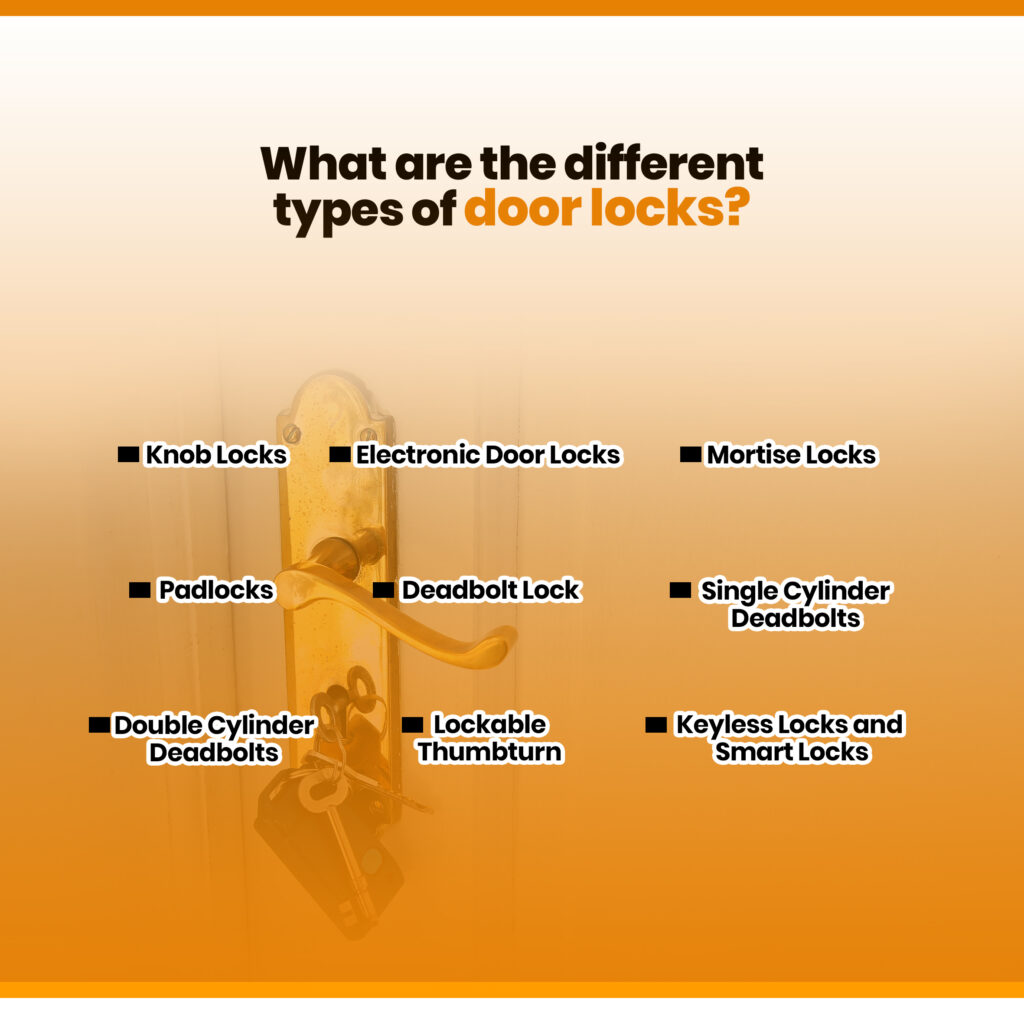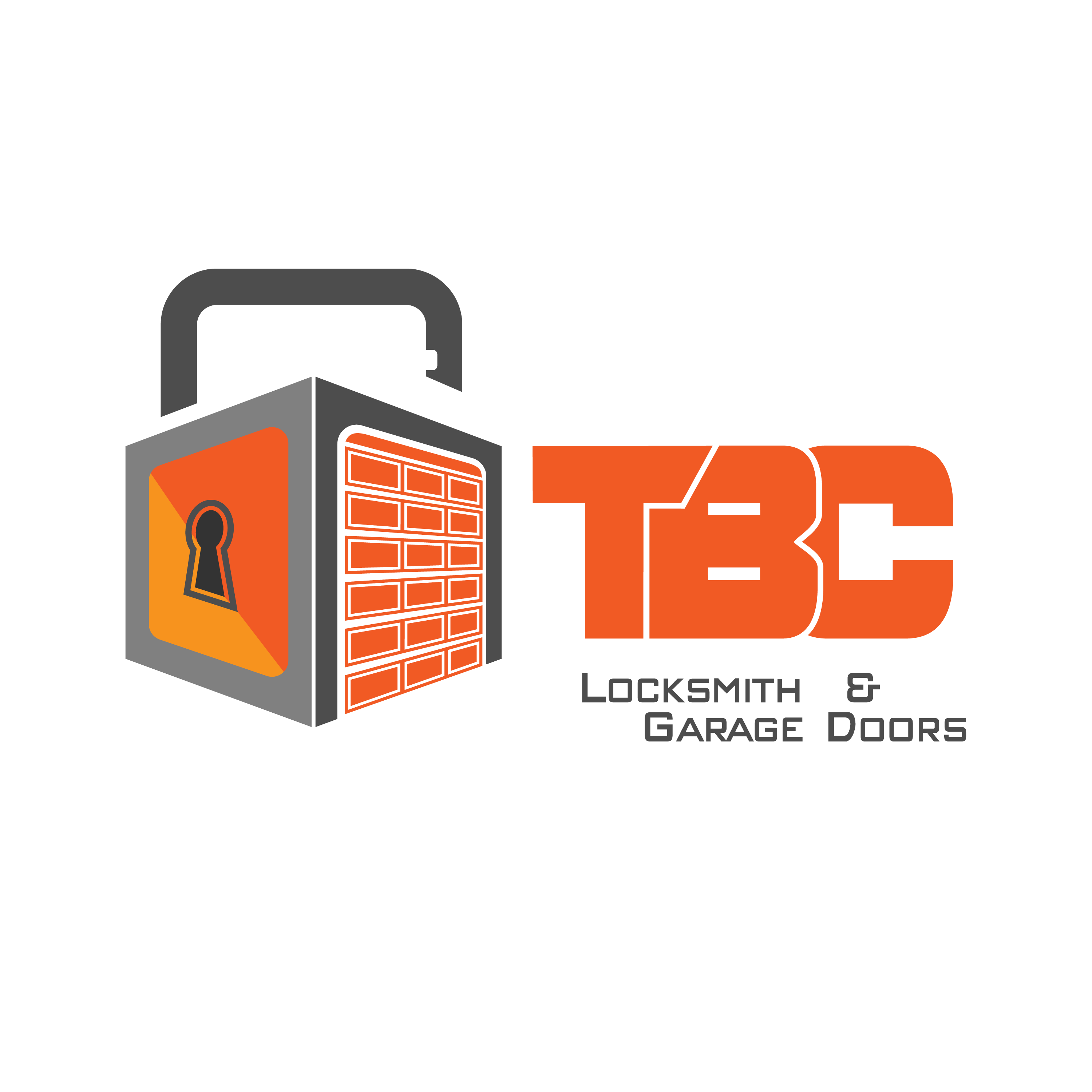How Do Locks Work?
Have you ever wondered what goes on when you operate your door lock? Locks are an interesting gadget, and understanding how they work can be very helpful when you have a faulty lock that requires fixing. In this article, discover everything you need to know about how locks work.
What is Inside of a Door Lock?

A door lock consists of different parts. These parts come together to ensure that your lock functions smoothly and effectively. Some of these door parts include:
1. Cylinder
The cylinder, also known as the lock body, is where the key is inserted in the door lock. When locked, the cylinder engages a set of spring-loaded pins, preventing the cylinder from turning. Once a key is inserted, the uneven edge pushes the pins up until they fit the key’s height within the lock body. The cylinder essentially recognizes the right key when the pins are all in their proper places. This causes the cylinder to open, allowing the bolt to move and opening the door.
2. Latch/Bolt
The lock engages a bolt in the door. This metal extends into the door frame from the door while holding it closed. Latches or bolts come in two main styles – a deadbolt and a spring bolt.
Deadbolt
Deadbolts do not possess the spring loading mechanism and, as such, can be unlocked and locked at any time. A knob on one side of the door or a key will easily open a deadbolt. A deadbolt is regarded as a more secure lock choice, especially if the lock has a deadbolt plunger. Also known as a guard bolt, a deadbolt plunger is smaller and usually situated next to the deadbolt. Its ket function is to prevent the lock from being picked.
Spring bolt
Pring bolts are a type of latch held in place using a spring clip. To unlock the bolt, the spring is compressed, and when released, it snaps into a locked position. This type of door locks automatically when closed.
3. Box and Strike Plate
The bolt usually extends into a small square hole from the cylinder. This hole is known as the box. It is designed to secure the bolt securely in the door frame once the lock is engaged. The metal plate which is attached to the frame of the door is known as the strike plate. The main purpose of the strike plate is to direct the bolt into the box of the frame from the cylinder, reinforcing the lock mechanism.
How Do Keys Open Locks?
Inside a lock such as a pin tumbler lock, you will find pins. Upper pins are situated between the pin tumblers and the springs. The upper pins and spring are usually completely extended while the pin tumblers are properly aligned in the barrel of the lock. Upon insertion of a key, the springs press against the pin tumblers, pushing them into the upper chamber pins and causing the springs to compress. The pins then align flush along the shear line.
The pins are fashioned to be different in configuration and height. These will align with the key cuts on the correct key. When a key with a matching profile is inserted into the lock, it aligns the pins correctly. This means that the shear line has no pins in the way, allowing the key to turning. The cam that rotates to catch the lock’s bolt is triggered as soon as the key rotates the barrel. This rotation allows the lock to either engage or unlock.
When locks are keyed similarly, it means that the tumbler pins are coordinated in the same fashion. If the size and pattern of the pins have been configured to be identical, then one key will be able to open each lock.
Are Any Door Locks Unpickable?
Any lock that you can open correctly can be opened incorrectly. For every lock, there is a bypass or a pick that can render the lock vulnerable. There is no perfect lock; there is always a flaw that one can exploit with every lock.
Many locks claim to be unpickable; this is just marketing. Bear in mind that a lock is designed to lock and is also designed to open. Lock picking is pretending to be the right key until it works.
Which Door Lock is the Hardest to Pick?
It is one thing to buy a high-end quality lock that proves extremely difficult to pick. It is another thing to make use of these locks correctly. Buying a quality lock and putting it on a cheap, lightweight door will render it ineffective. Your doors will be more susceptible to break-ins if you do not protect them correctly.
Because you have increased security against lockpicking doesn’t reflect on your overall security.
What are the Different Types of Door Locks?

There are several different types of door locks. Some of them include:
1. Knob Locks
These are the most common type of door locks to be installed on the inside doors. Knob locks are not fashioned for external use as they offer limited amounts of security. However, when combined with deadbolt locks, they can be installed on exterior doors for extra security.
Door Knob locks are designed with a locking mechanism located within the doorknob. These locks have knobs located on either side, allowing you to lock the door from outside or inside.
2. Mortise Locks
Mortise locks are widely used for entry glass doors, commercial doors and apartment doors. They are very powerful and consist of intricate hardware that is mounted and held securely in place using a set screw and a cam that actuates the locking hardware.
Mortise locks come in different types, including five-lever mortise locks and three lever mortise locks. The number of levers available in the levers of a mortise lock lets you know how many points the door locks in the frame: the more the levers, the more secure the lock.
3. Padlocks
These are portable, simple locks. They are not like other types of locks that are permanently attached to a door. You can affix a padlock to your gate, door, fence or chain to protect your space from vandalism or theft. The padlocks contain a shouldered shackle. This is a part where the shoulders of the padlock raise the sides of the shackle to prevent bolt cutters from going through it.
Padlocks are grouped into two:
- Keyed padlocks (non-re-keyable and rekeyable)
- Combination padlocks
4. Deadbolt Lock
These deadbolts are considered one of the most popular types of door locks. They are mostly used for residential purposes. A key opens them without the use of a spring or by turning the knob. Deadbolts have a unique locking mechanism that reduces the risk of forced entry. Their lock system is secure enough to prevent a burglar from breaking in through the door.
Deadbolt locks are available in three different types:
Single Cylinder Deadbolts
Single-cylinder deadbolt makes use of s thumb turn ((rosary) on the inside and a key cylinder on the outside to open the locks. The primary weakness of deadbolts is that the door can be opened using the thumb turn if access to the inside is possible.
Double Cylinder Deadbolts
Double cylinder deadbolts use a key cylinder both outside and inside the door to solve security. The downside to these types of cylinder deadbolts is that they always need a key to open the door from inside if locked. This can be dangerous in the event of an emergency.
Lockable Thumbturn
These types of locks are a hybrid between a double and single deadbolt. It sports a thumb turn on the inside which works just like a normal single cylinder deadbolt. The only difference is that the thumb turn can be locked easily using a key not to unlock or lock the door. The thumb turn can be locked easily so that even access to the door from inside will not guarantee that you can unlock the deadbolt. Such a deadbolt provides maximum security and flexibility in most situations.
5. Keyless Locks and Smart Locks
These types of locks do not need to be unlocked with keys. They are operated with a card system or a keypad that requires a special code. Keyless locks are found in offices and hotel rooms and are becoming more commonplace for residential properties and apartment buildings.
With electronic locks, homeowners can track how often the locks are used. These locks can also highlight the people who have access to the lock, making it a lot easier to find out who has access to the property at given times. This will help improve security and serve as beneficial if any suspicious activity is noticed.
6. Electronic Door Locks
Electronic locks are now gaining popularity in the housing industry today. These types of locks are revolutionizing security. They are designed to receive a specific set of instructions from a designated device to be unlocked and locked. In most cases, these instructions are transmitted wirelessly, obeying communication protocols.
Conclusion
If you are in Toronto or the GTA, contact TBC Locksmith for your top-notch smart lock solutions today. Our services include smart lock install and repair, rekeying locks, and making new keys. We are available 24/7 to offer proper security solutions. At TBC Locksmith, we are fully equipped with a large inventory of high-quality locksmith tools and products to ensure we promptly respond to your needs.
All our locksmiths are insured and licensed, and we offer affordable pricing with a 90-day guarantee. Contact us today for all your locksmith needs. Have you ever wondered what goes on when you operate your door lock? Locks are an interesting gadget, and understanding how they work can be very helpful when you have a faulty lock that requires fixing. In this article, discover everything you need to know about how locks work.
